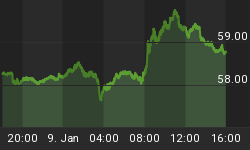Nominal retail sales were reported to be up 0.5% in April. If these nominal sales are adjusted by the CPI for commodities (goods as opposed to services), we find that "real" retail sales in April fell 0.6%. You might be able to make out in Chart 1 that price-adjusted retail sales peaked in January. May non-auto nominal retail sales appear to be subdued if there is any merit to the ICSC-UBS Warburg weekly chain store index. The three-week average of this index for May is flat vs. the April monthly average. If CPI-adjusted retail sales remain at the April level in May and June, they will have contracted at an annual rate of 3.2% in the second quarter. If CPI-adjusted retail sales increase by 1.0% in both May and June, they will have grown at an annual rate of just 0.7% in the second quarter. As a point of reference, CPI-adjusted retail sales grew at an annual rate of 13.1% in the first quarter.
Chart 1
The guessing game for the FOMC and for those of guessing what the FOMC will be guessing is whether the weak second-quarter real retail sales is a harbinger of generally weaker economy or an aberration. The Fed "prints" money and prints some of the statistics pertaining to the money it prints, but it pays little attention to either. But I do. Plotted in Chart 2 is the behavior of the CPI-adjusted M2 money supply. On a year-over-year basis, this measure of real M2 was up only 1.3% in April. Although year-over-year growth in real M2 has been lower in this cycle than the April figure, in an historical context, real M2 growth of 1.3% is weak - weaker than what preceded the last recession. In the three months ended April, real M2 contracted at an annual rate of 0.4%. Nominal M2 growth for May is looking anemic. This behavior of real M2 suggests to me that the weakness in real retail sales in the second quarter is more than a one-off fluke, but a warning of continued softness. Another leading indicator that the FOMC seems to ignore but I don't is the yield spread between the 10-year Treasury note and the FOMC's target fed funds rate. As shown in Chart 3, this spread was barely positive at 4 basis points yesterday. Again, in an historical context, a 4 basis point spread represents a restrictive monetary policy. On July 5, 1995, this spread was 19 basis points. On July 6, 1995, the FOMC cut the fed funds rate by 25 basis points because the economy had no lift. I know - it's different this time. But when two leading indicators related to monetary policy line up on the same side and when the sector of the economy that tends to lead the rest - housing - is sucking air, how confident can you be that weak second quarter retail sales are just an aberration? If the FOMC chooses to ignore these leading indicators and tightens on June 29, you also might want to tighten - tighten your seatbelt.
Chart 2
Chart 3















